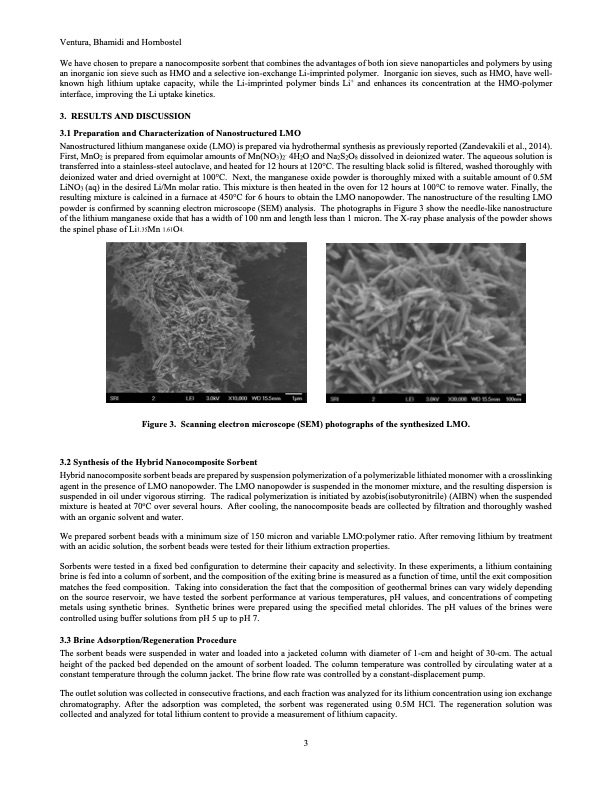
PDF Publication Title:
Text from PDF Page: 003
Ventura, Bhamidi and Hornbostel We have chosen to prepare a nanocomposite sorbent that combines the advantages of both ion sieve nanoparticles and polymers by using an inorganic ion sieve such as HMO and a selective ion-exchange Li-imprinted polymer. Inorganic ion sieves, such as HMO, have well- known high lithium uptake capacity, while the Li-imprinted polymer binds Li+ and enhances its concentration at the HMO-polymer interface, improving the Li uptake kinetics. 3. RESULTS AND DISCUSSION 3.1 Preparation and Characterization of Nanostructured LMO Nanostructured lithium manganese oxide (LMO) is prepared via hydrothermal synthesis as previously reported (Zandevakili et al., 2014). First, MnO2 is prepared from equimolar amounts of Mn(NO3)2. 4H2O and Na2S2O8 dissolved in deionized water. The aqueous solution is transferred into a stainless-steel autoclave, and heated for 12 hours at 120°C. The resulting black solid is filtered, washed thoroughly with deionized water and dried overnight at 100°C. Next, the manganese oxide powder is thoroughly mixed with a suitable amount of 0.5M LiNO3 (aq) in the desired Li/Mn molar ratio. This mixture is then heated in the oven for 12 hours at 100°C to remove water. Finally, the resulting mixture is calcined in a furnace at 450°C for 6 hours to obtain the LMO nanopowder. The nanostructure of the resulting LMO powder is confirmed by scanning electron microscope (SEM) analysis. The photographs in Figure 3 show the needle-like nanostructure of the lithium manganese oxide that has a width of 100 nm and length less than 1 micron. The X-ray phase analysis of the powder shows the spinel phase of Li1.35Mn 1.61O4. Figure 3. Scanning electron microscope (SEM) photographs of the synthesized LMO. 3.2 Synthesis of the Hybrid Nanocomposite Sorbent Hybrid nanocomposite sorbent beads are prepared by suspension polymerization of a polymerizable lithiated monomer with a crosslinking agent in the presence of LMO nanopowder. The LMO nanopowder is suspended in the monomer mixture, and the resulting dispersion is suspended in oil under vigorous stirring. The radical polymerization is initiated by azobis(isobutyronitrile) (AIBN) when the suspended mixture is heated at 70oC over several hours. After cooling, the nanocomposite beads are collected by filtration and thoroughly washed with an organic solvent and water. We prepared sorbent beads with a minimum size of 150 micron and variable LMO:polymer ratio. After removing lithium by treatment with an acidic solution, the sorbent beads were tested for their lithium extraction properties. Sorbents were tested in a fixed bed configuration to determine their capacity and selectivity. In these experiments, a lithium containing brine is fed into a column of sorbent, and the composition of the exiting brine is measured as a function of time, until the exit composition matches the feed composition. Taking into consideration the fact that the composition of geothermal brines can vary widely depending on the source reservoir, we have tested the sorbent performance at various temperatures, pH values, and concentrations of competing metals using synthetic brines. Synthetic brines were prepared using the specified metal chlorides. The pH values of the brines were controlled using buffer solutions from pH 5 up to pH 7. 3.3 Brine Adsorption/Regeneration Procedure The sorbent beads were suspended in water and loaded into a jacketed column with diameter of 1-cm and height of 30-cm. The actual height of the packed bed depended on the amount of sorbent loaded. The column temperature was controlled by circulating water at a constant temperature through the column jacket. The brine flow rate was controlled by a constant-displacement pump. The outlet solution was collected in consecutive fractions, and each fraction was analyzed for its lithium concentration using ion exchange chromatography. After the adsorption was completed, the sorbent was regenerated using 0.5M HCl. The regeneration solution was collected and analyzed for total lithium content to provide a measurement of lithium capacity. 3PDF Image | Selective Recovery of Lithium from Brines

PDF Search Title:
Selective Recovery of Lithium from BrinesOriginal File Name Searched:
Ventura.pdfDIY PDF Search: Google It | Yahoo | Bing
Product and Development Focus for Infinity Turbine
ORC Waste Heat Turbine and ORC System Build Plans: All turbine plans are $10,000 each. This allows you to build a system and then consider licensing for production after you have completed and tested a unit.Redox Flow Battery Technology: With the advent of the new USA tax credits for producing and selling batteries ($35/kW) we are focussing on a simple flow battery using shipping containers as the modular electrolyte storage units with tax credits up to $140,000 per system. Our main focus is on the salt battery. This battery can be used for both thermal and electrical storage applications. We call it the Cogeneration Battery or Cogen Battery. One project is converting salt (brine) based water conditioners to simultaneously produce power. In addition, there are many opportunities to extract Lithium from brine (salt lakes, groundwater, and producer water).Salt water or brine are huge sources for lithium. Most of the worlds lithium is acquired from a brine source. It's even in seawater in a low concentration. Brine is also a byproduct of huge powerplants, which can now use that as an electrolyte and a huge flow battery (which allows storage at the source).We welcome any business and equipment inquiries, as well as licensing our turbines for manufacturing.| CONTACT TEL: 608-238-6001 Email: greg@infinityturbine.com | RSS | AMP |